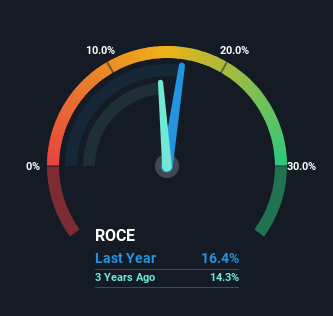There are a few key trends to look for if we want to identify the next multi-bagger. Firstly, we'd want to identify a growing return on capital employed (ROCE) and then alongside that, an ever-increasing base of capital employed. Ultimately, this demonstrates that it's a business that is reinvesting profits at increasing rates of return. So on that note, SWCC (TSE:5805) looks quite promising in regards to its trends of return on capital.
Return On Capital Employed (ROCE): What Is It?
Just to clarify if you're unsure, ROCE is a metric for evaluating how much pre-tax income (in percentage terms) a company earns on the capital invested in its business. Analysts use this formula to calculate it for SWCC:
Return on Capital Employed = Earnings Before Interest and Tax (EBIT) ÷ (Total Assets - Current Liabilities)
0.16 = JP¥16b ÷ (JP¥168b - JP¥69b) (Based on the trailing twelve months to June 2024).
Thus, SWCC has an ROCE of 16%. On its own, that's a standard return, however it's much better than the 8.4% generated by the Electrical industry.
See our latest analysis for SWCC

In the above chart we have measured SWCC's prior ROCE against its prior performance, but the future is arguably more important. If you'd like, you can check out the forecasts from the analysts covering SWCC for free.
What The Trend Of ROCE Can Tell Us
Investors would be pleased with what's happening at SWCC. The data shows that returns on capital have increased substantially over the last five years to 16%. The company is effectively making more money per dollar of capital used, and it's worth noting that the amount of capital has increased too, by 79%. The increasing returns on a growing amount of capital is common amongst multi-baggers and that's why we're impressed.
One more thing to note, SWCC has decreased current liabilities to 41% of total assets over this period, which effectively reduces the amount of funding from suppliers or short-term creditors. This tells us that SWCC has grown its returns without a reliance on increasing their current liabilities, which we're very happy with. Nevertheless, there are some potential risks the company is bearing with current liabilities that high, so just keep that in mind.
The Bottom Line
To sum it up, SWCC has proven it can reinvest in the business and generate higher returns on that capital employed, which is terrific. And with the stock having performed exceptionally well over the last five years, these patterns are being accounted for by investors. In light of that, we think it's worth looking further into this stock because if SWCC can keep these trends up, it could have a bright future ahead.
On a final note, we've found 2 warning signs for SWCC that we think you should be aware of.
For those who like to invest in solid companies, check out this free list of companies with solid balance sheets and high returns on equity.
New: Manage All Your Stock Portfolios in One Place
We've created the ultimate portfolio companion for stock investors, and it's free.
• Connect an unlimited number of Portfolios and see your total in one currency
• Be alerted to new Warning Signs or Risks via email or mobile
• Track the Fair Value of your stocks
Have feedback on this article? Concerned about the content? Get in touch with us directly. Alternatively, email editorial-team (at) simplywallst.com.
This article by Simply Wall St is general in nature. We provide commentary based on historical data and analyst forecasts only using an unbiased methodology and our articles are not intended to be financial advice. It does not constitute a recommendation to buy or sell any stock, and does not take account of your objectives, or your financial situation. We aim to bring you long-term focused analysis driven by fundamental data. Note that our analysis may not factor in the latest price-sensitive company announcements or qualitative material. Simply Wall St has no position in any stocks mentioned.
About TSE:5805
SWCC
Manufactures and sells energy, infrastructure, and communication components in Japan and internationally.
Excellent balance sheet average dividend payer.
Market Insights
Community Narratives



